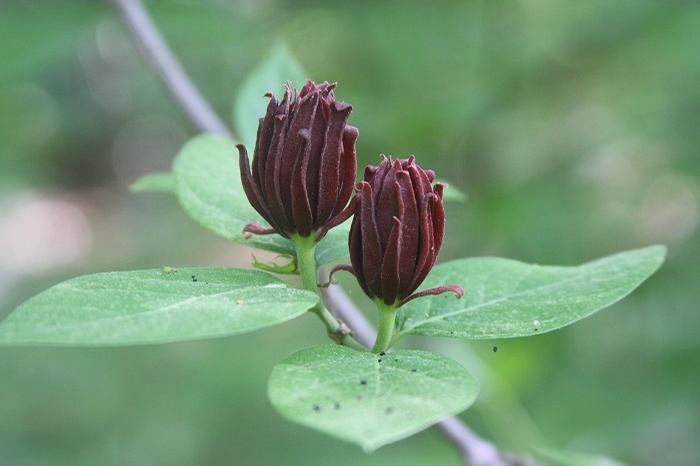General Description
Bloom Description: Maroon, tulip-like flowers bloom from May through June.
Growth Habit & Shape: Calycanthus is a shrub native to the Appalachians south of New England, although it is found ornamentally in Massachusetts and Connecticut. It forms an oval- to vase-shaped shrub with many branches. It has a tendency to sucker, forming large, broad stands.
Soil Preferences: This shrub prefers rich loam, but can be grown in average garden soil that is well drained. It will tolerate clay soils.
Root Description: Calycanthus has a tough, fibrous, spreading root system.
Garden Uses: Carolina allspice can be used as a specimen or in a naturalized setting. It is easy to grow and is tolerant of a wide range of conditions. It prefers a sunny location where it remains a bit shorter and well rounded, but also tolerates part shade where it grows a bit leggy. The flowers are fantastic and the fruits provide wierd winter interest, with a slightly sac-like shape filled with large mahogany seeds. The fall color is a clear yellow.
Best Management & Maintenance: Periodic pruning can help this species keep its shape and compact growth form. Removing 1/3 of the larger stalks each spring will encourage a thicker shrub. Remove suckers if spreading becomes problematic.
Common Problems: Biotic: No disease or pest problems. Easy, trouble-free plant
Benefits
Ornamental Value: Calycanthus floridus is a coarse shrub that is good as a border or in a hedgerow. It can be used as a specimen as well. The flowers are unique, interesting and fragrant. In sun the plant produces abundant flowers. Fall color is a nice, clear yellow and the unique fruits persist throughout the winter.
Wildlife Benefits: The shrub can be a good nesting site for birds, and the flowers are attractive to numerous insects, especially beetles and flies.
Other Practical/Environmental Benefits: Tolerant of a wide range of soil and light conditions, the plant will adapt to changes in the landscape, and works well to anchor soil in place.
Use in place of: Berberis thunbergii, Rosa multiflora, Rhamnus sp.
Ecology
Habitat:
In its native range, this plant grows in deciduous or mixed woodlands, along streams and rivers, and in woodland margins.
Response to Disturbance: Calycanthus floridus thrives in challenging conditions, tolerates deer browse, and responds very well to pruning or clear-cutting.
Native State Distributions:
Canada: -
USA: AL, FL, GA, MD, MS, NC, PA, SC, TN, VA
Wetland indicator status: FACU
References
Return to Top

